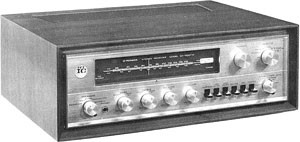The Pioneer SX-1000TW, a solid-state AM/FM receiver from 1971, represents a significant era in audio technology as the industry transitioned from tubes to transistors. This receiver, while not as visually striking as some later Pioneer models, offers a robust build and warm sound that continues to appeal to vintage audio enthusiasts. It stands as a testament to Pioneer’s engineering prowess during this pivotal period, delivering a substantial 50 watts per channel of RMS power.
 Pioneer SX-1000TW Receiver Front View
Pioneer SX-1000TW Receiver Front View
Delving into the Specifications of the Pioneer SX-1000TW
The Pioneer SX-1000TW boasts technical specifications that were impressive for its time and remain respectable even by today’s standards for vintage equipment. Its tuning range covers both FM and MW bands, catering to a broad spectrum of radio listening. The power output is rated at 50 watts per channel into 8 ohms in stereo mode, sufficient for driving a wide range of speakers in typical listening environments.
Frequency response is stated as 20Hz to 50kHz, indicating a wide sonic range capable of reproducing both deep bass and crisp highs. Total harmonic distortion is listed at 0.5%, a figure that, while not ultra-low by modern standards, was typical for solid-state receivers of the early 1970s. Many listeners find this level of distortion inaudible under normal listening conditions, contributing to the receiver’s warm and pleasant sound. The damping factor of 25 suggests good control over speaker movement, leading to tighter bass response.
Input sensitivity specifications reveal the versatility of the Pioneer SX-1000TW in accommodating various audio sources. It offers 2.4mV sensitivity for moving magnet (MM) phono cartridges, 51mV for ceramic cartridges, and 200mV for both DIN and line-level inputs. Signal-to-noise ratios are reported as 80dB for MM phono and 90dB for line inputs, indicating quiet operation and minimal background noise. The receiver is designed to work with speakers ranging from 4 ohms to 16 ohms impedance, providing flexibility in speaker pairing. Internally, the unit incorporates 4 ICs, 1 FET, 42 transistors, and 34 diodes, reflecting the solid-state technology of its era. Physically, the Pioneer SX-1000TW measures 405 x 137 x 350mm and weighs 10.6kg, indicative of its robust construction.
User Reviews and Sound Impressions of the SX-1000TW
User reviews of the Pioneer SX-1000TW on platforms like Hifiengine highlight its sonic characteristics and overall performance. One reviewer, sonyvfet, praised the receiver’s “crystal clear” sound in its stock condition and noted the significant improvement in soundstage after upgrading the speaker output coupling capacitors. This user found that the upgraded SX-1000TW could rival even tube amplifiers in sound quality, outperforming other vintage receivers like the Marantz 2270 and Sansui 5000X. This review underscores the potential for sonic enhancement through component upgrades, a common practice among vintage audio enthusiasts.
Another reviewer, 71451RC, expressed amazement at the “clear, deep sound” of the SX-1000TW, especially considering its modest power rating. This user emphasized that the receiver is more than adequate for typical home listening rooms and appreciated its performance with Pioneer CS-88a speakers. vermontaigne described the SX-1000TW as a “masterpiece of engineering for 1971,” highlighting its ability to produce a “never-fatiguing sound” reminiscent of tube amps, despite being solid-state. This reviewer also appreciated its robust build and clean layout, comparing its sound favorably to other vintage receivers in their collection, including a Pioneer SX-727.
rkgren1 noted the “very warm sound” of their SX-1000TW and praised the strong tuner section. They also commented on the solid build quality, including the thick plywood case with walnut veneer, contributing to the receiver’s substantial feel. These collective reviews paint a picture of the Pioneer SX-1000TW as a well-regarded vintage receiver with a warm, enjoyable sound, strong tuner performance, and robust build quality, making it a desirable piece for collectors and vintage audio lovers.
The Pioneer SX-1000TW in the Landscape of Vintage Audio
The Pioneer SX-1000TW occupies an interesting position in the history of vintage audio. As an early solid-state receiver, it represents a departure from the tube-based technology that dominated prior decades. While some audiophiles still prefer the warmth of tube amplifiers, the SX-1000TW aimed to bridge the gap, offering a sound that was considered “pretty close to tube amps” by some reviewers, while leveraging the reliability and efficiency of solid-state components. Its 50 watts per channel power output was generous for 1971, placing it in a competitive segment of the market.
Today, the Pioneer SX-1000TW is valued for its historical significance, its warm and musical sound, and its robust construction. While it may not possess the sleek aesthetics of some later Pioneer receivers, its understated, 1960s-inspired design has its own charm. The positive user reviews and the availability of service manuals and related documentation online further enhance its appeal to those interested in restoring or maintaining vintage audio equipment. For those seeking an entry point into vintage hi-fi or a reliable and warm-sounding receiver for a classic audio setup, the Pioneer SX-1000TW remains a compelling option, often available at reasonable prices in the used market.

